The Battle of Long Island
In the Battle of Long Island, the first major battle of the American Revolution after the United States declared independence from England, the British overwhelmingly defeated the Continental Army. Both Jedediah Mills (father of Mary Platt Mills) and William Mills (father of William Mills of Erie County) fought in the battle alongside other Mills family members in Captain Nathaniel Platt’s Smithtown Regiment of Minute Men of Suffolk County, under the command of General Nathaniel Woodhull.

— 1876, The British Fleet in the Lower Bay, Harper’s Magazine, public domain image uploaded by member to wikipedia.org. View largest available size.
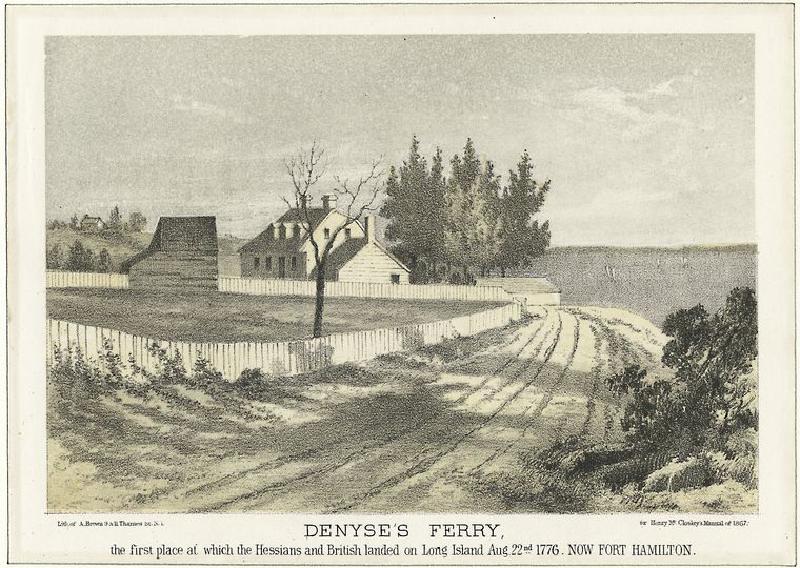
Denyse’s Ferry, the first place at which the Hessians and British landed on Long Island Aug. 22nd 1776 NOW FORT HAMILTON
— Emmet Collection of Manuscripts Etc. Relating to American History. The generals of the American Revolution. Volume 3: William Alexander, Earl of Stirling. Public domain image uploaded by member to wikipedia.org. View largest available size.
The Battle of Long Island, also known as the Battle of Brooklyn and the Battle of Brooklyn Heights, was an action of the American Revolutionary War fought on August 27, 1776, at the western edge of Long Island in present-day Brooklyn, New York. The British defeated the Americans and gained access to the strategically important Port of New York, which they held for the rest of the war. It was the first major battle to take place after the United States declared its independence on July 4, and in troop deployment and combat, it was the largest battle of the war.
...On August 21, the British landed on the shores of Gravesend Bay in southwest Kings County, across the Narrows from Staten Island and more than a dozen miles south of the established East River crossings to Manhattan. After five days of waiting, the British attacked the American defenses on the Guan Heights. Unknown to the Americans, however, Howe had brought his main army around their rear and attacked their flank soon after. The Americans panicked, resulting in twenty percent losses through casualties and capture, although a stand by 400 Maryland and Delaware troops prevented greater losses. The remainder of the army retreated to the main defenses on Brooklyn Heights. The British dug in for a siege, but on the night of August 29–30, Washington evacuated the entire army to Manhattan without the loss of supplies or a single life. The Continental Army was driven out of Manhattan entirely after several more defeats and was forced to retreat through New Jersey to Pennsylvania.
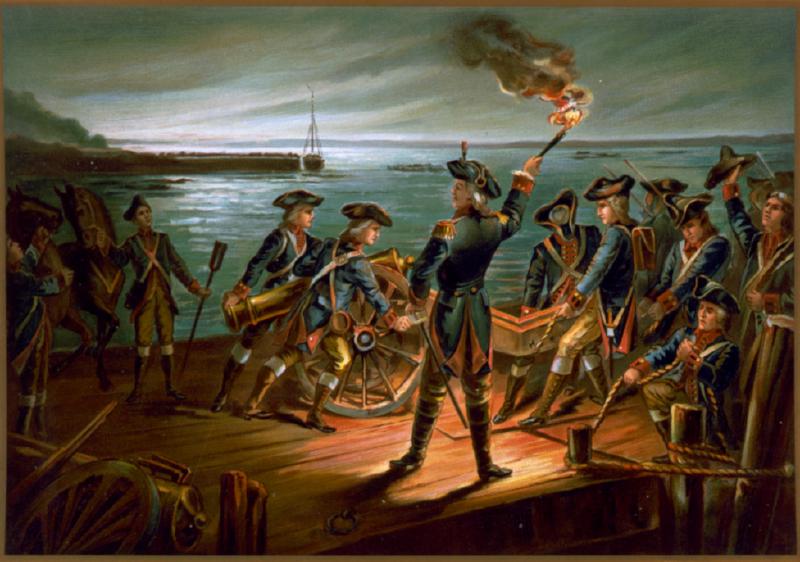
— 1899, U.S. Army-Artillery retreat from Long Island. United States New York Long Island, 1899. Akron, Ohio: The Werner Company. [Photograph] Retrieved from the Library of Congress, https://www.loc.gov/item/95507855/. View largest available size.
Several members of the Mills family fought as Minute Men in the Continental Army, and specifically fought in the Battle of Long Island. Based on strikingly similar accounts of each in the published Mills genealogies that make note of it, they each “signed the Association in May 1775” joining “Capt. Nathaniel Platt’s Smithtown company of Col. Josiah Smith’s First Regiment of Suffolk County Minute Men”.
Sergeant Jonas Mills (19 Mar 1753 to 06 May 1811), Jedediah Mills’ brother.
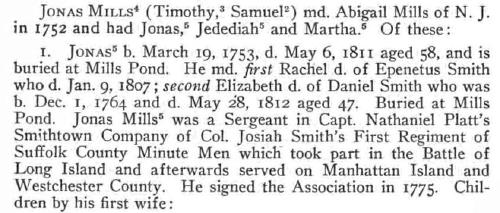
JONAS MILLS4 (Timothy,3 Samuel2) md. Abigail Mills of N. J. in 1752 and had Jonas,5 Jedediah5 and Martha.5 Of these:
- Jonas5 b. March 19, 1753, d. May 6, 1811 aged 58, and is buried at Mills Pond. He md. first Rachel d. of Epenetus Smith who d. Jan. 9, 1807; second Elizabeth d. of Daniel Smith who was b. Dec. 1, 1764 and d. May 28, 1812 aged 47. Buried at Mills Pond. Jonas Mills5 was a Sergeant in Capt. Nathaniel Platt’s Smithtown Company of Col. Josiah Smith’s First Regiment of Suffolk County Minute Men which took part in the Battle of Long Island and afterwards served on Manhattan Island and Westchester County. He signed the Association in 1775. …
— 1919, Genealogies of Long Island families : a collection of genealogies relating to the following Long Island families: Dickerson, Mitchill, Wickham, Carman, Raynor, Rushmore, Satterly, Hawkins, Arthur Smith, Mills, Howard, Lush, Greene, Compiled by Charles J. Werner, Mainly From Records Left By Benjamin F. Thompson, Historian of Long Island, p110, Logan Utah FamilySearch Library, familysearch.org. Partial transcription. View largest available size.
Corporal Jedediah Mills (04 Nov 1755 to 21 Dec 1828), Mary Platt’s father.
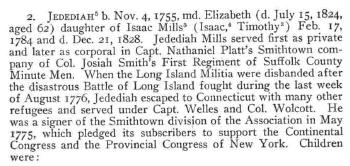
- Jedediah5 b. Nov. 4, 1755, md. Elizabeth (d. July 15, 1824, aged 62) daughter of Isaac Mills5 (Isaac,4 Timothy3) Feb. 17, 1784 and d. Dec. 21, 1828. Jedediah Mills served first as private and later as corporal in Capt. Nathaniel Platt’s Smithtown company of Col. Josiah Smith’s First Regiment of Suffolk County Minute Men. When the Long Island Militia were disbanded after the disastrous Battle of Long Island fought during the last week of August 1776, Jedediah escaped to Connecticut with many other refugees and served under Capt. Welles and Col. Wolcott. He was a signer of the Smithtown division of the Association in May 1775, which pledged its subscribers to support the Continental Congress and the Provincial Congress of New York. …
— 1919, Genealogies of Long Island families : a collection of genealogies relating to the following Long Island families: Dickerson, Mitchill, Wickham, Carman, Raynor, Rushmore, Satterly, Hawkins, Arthur Smith, Mills, Howard, Lush, Greene, Compiled by Charles J. Werner, Mainly From Records Left By Benjamin F. Thompson, Historian of Long Island, p111, Logan Utah FamilySearch Library, familysearch.org. View largest available size.
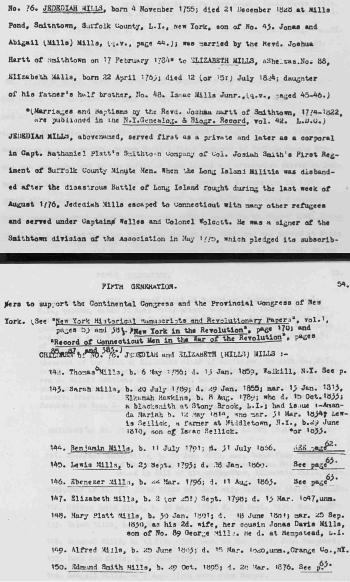
No. 76 JEDEDIAH MILLS, born 4 November 1755; died 21 December 1828 at Mills Pond, Smithtown, Suffolk County, L.I., New York, son of No. 43. Jonas and Abigail (Mills) Mills, (q.v., page 44); was married by the Revd. Joshua Hartt of Smithtown on 17 February 1784* to ELIZABETH MILLS, She was No. 88, Elizabeth Mills, born 22 April 1763; died 12 (or 15?) July 1824; daughter of his father’s half brother, No. 48. Isaac Mills Junr., (q.v., paged 45-46.)
- (Marriages and Baptisms by the Revd. Joshua Hartt of Smithtown, 1774-1882, are published in the N.Y. Genealog. & Biogr. Record, vol. 42. L.D.O.)
JEDEDIAH MILLS, abovenamed, served first as a private and later as a corporal in Capt. Nathaniel Platt’s Smithtown Company of Col. Josiah Smith’s First Regiment of Suffolk County Minute Men. When the Long Island Militia was disbanded after the disastrous Battle of Long Island fought during the last week of August 1776, Jedediah Mills escaped to Connecticut with many other refugees and served under Captain Welles and Colonel Wolcott. He was a signer of the Smithtown division of the Association in May 1775, which pledged its subscribers to support the Continental Congress and the Provincial Congress of New York. (See “New York Historical Manuscripts and Revolutionary Papers”, vol. 1, pages 53 and 58. “New York in the Revolution”, page 170; and “Record of Connecticut Men in the War of the Revolution”, pages 85, 87, and 383.)
…
— 01 May 1939, A Documentary history of the family of Mills : descended from George Mills of Hempstead and Jamaica by Lewis D. Cook, p53-54, familysearch.org. Partial transcription.View largest available size.
Jedediah Mills married Elizabeth (Mills) Mills (22 Apr 1763 to [12 or 15] Jul 1826), William Mill’s sister. Jedediah Mills was the father of Mary Platt Mills (30 Jan 1801 to 18 Jun 1881), Jonas Davis Mills’ second wife, step-mother to Edward Mills.
William Mills (27 Aug 1757 to 12 Jun 1837), Elizabeth Mills’ brother.
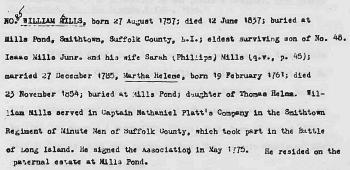
NO. 85 William Mills, born 27 August 1757; died 12 June 1837; buried at Mills Pond, Smithtown, Suffolk County, L.I.; eldest surviving son of No. 48. Isaac Mills Junr. and his wife Sarah (Phillips) Mills (q.v. p. 45); married 27 December 1785, Martha Helme, born 19 February 1761; died 23 November 1854; buried at Mills Pond; daughter of Thomas Helme. William Mills served in Captain Nathaniel Platt’s Company in the Smithtown Regiment of Minute Men of Suffolk County, which took part in the Battle of Long Island. He signed the Association in May 1775. He resided on the paternal estate at Mills Pond.
— 01 May 1939, A Documentary history of the family of Mills : descended from George Mills of Hempstead and Jamaica by Lewis D. Cook, p57, familysearch.org. View largest available size.
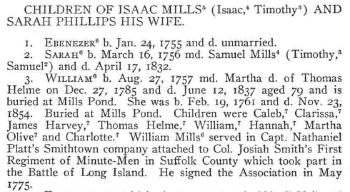
CHILDREN OF ISAAC MILLS5(Isaac,4 Timothy3) AND SARAH PHILLIPS HIS WIFE.
Ebenezer6 b. Jan 24, 1755 and d unmarried.
Sarah6 b. March 16, 1756 md. Samuel Mills4 (Timothy,3 Samuel2) and d. April 17, 1832.
William6 b. Aug. 27, 1757 md. Martha d. of Thomas Helme on Dec. 27, 1785 and d. June 12, 1837 aged 79 and is buried at Mills Pond. She was b. Feb. 19, 1761 and d. Nov. 23, 1854. Buried at Mills Pond. Children were Caleb,7 Clarissa,7 James Harvey,7 Thomas Helme,7 William7, Hannah7, Martha Olive7 and Charlotte.7 William Mills6 served in Capt. Nathaniel Platt’s Smithtown company attached to Col. Josiah Smith’s First Regiment of Minute-Men in Suffolk County which took part in the Battle of Long Island. He signed the Association in May 1775-
— 1919, Genealogies of Long Island families : a collection of genealogies relating to the following Long Island families: Dickerson, Mitchill, Wickham, Carman, Raynor, Rushmore, Satterly, Hawkins, Arthur Smith, Mills, Howard, Lush, Greene, Compiled by Charles J. Werner, Mainly From Records Left By Benjamin F. Thompson, Historian of Long Island, p107, Logan Utah FamilySearch Library, familysearch.org. View largest available size.
William Mills is the father of William Mills of Erie County NY who fought in the War of 1812, the “Second War of Independence”.
Yet another William Mills also fought in the battle.
William Mills (1754 to 19 Oct 1818), who also appears to be from Mills Pond. To distinguish him from William the father of William of Erie County, I will refer to this third William as the son of Jacob Mills (unknown to 20 Oct 1779).

- William7 md. 1831 Eleanor d. of John Perline of N. J. For his second wife Israel5 md. a d. of one Kellum, by whom he had no issue and died Oct. 19, 1818 aged 64. He was a member of Capt. Nathaniel Platt’s Smithtown company which was attached to Col. Josiah Smith’s First Regiment of Minute Men in Suffolk County which took part in the Battle of Long Island. He signed the Association in May 1775.
— 1919, Genealogies of Long Island families : a collection of genealogies relating to the following Long Island families: Dickerson, Mitchill, Wickham, Carman, Raynor, Rushmore, Satterly, Hawkins, Arthur Smith, Mills, Howard, Lush, Greene, Compiled by Charles J. Werner, Mainly From Records Left By Benjamin F. Thompson, Historian of Long Island, p110, Logan Utah FamilySearch Library, familysearch.org. Partial transcription. View largest available size.
The soldiers’ ages on the day the battle began:
| Age | Soldier |
|---|---|
| 23 | Sergeant Jonas Mills |
| 24 | Corporal Jedediah Mills |
| 19 | William Mills of Mills Pond |
| 22 | William Mills, son of Jacob |
Note that the battle began on the 19th birthday of William Mills of Mills Pond.
To try to make clearer the relationships among the Mills that are the primary subjects of this work, I created the following visual representation:
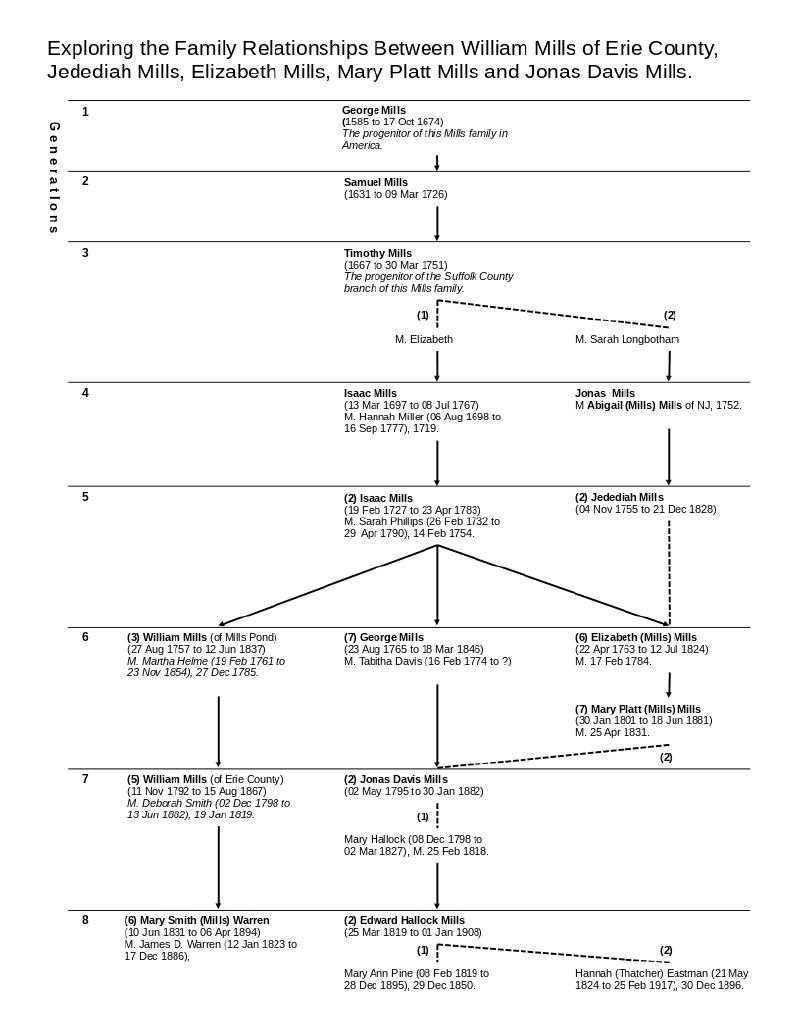
Note a number of interconnections. Sergeant Jonas and Jedediah were siblings. Their father Jonas was the first cousin of his wife Abigail Mills of New Jersey, whose father Samuel Mills (the junior) was the son of Samuel Mills (the senior) whose brother was Timothy Mills, the Suffolk County Mills progenitor. Elizabeth’s grandfather, Isaac Mills Sr., was her husband Jedediah Mills’ father’s half brother. Elizabeth and William of Mills Pond were siblings, and so that William was the uncle of Edward Mills’ father Jonas Davis and Jonas’ second wife Mary Platt. Jonas Davis and Mary Platt were cousins, as they shared common grandparents Isaac Mills Jr. (19 Feb 1727 to 23 Apr 1783) and Sarah (Phillips) Mills (26 Feb 1731 to 29 Apr 1790), who were themselves first cousins. (Although not shown in the diagram, Sarah Phillips’ parents were George Phillips (1698 to 21 Nov 1771) and Elizabeth (Mills) Phillips (1706 to 19 Apr 1775).) Isaac and Sarah’s son George Phillips Mills (23 Aug 1765 to 18 Mar 1846) was Jonas’ father and Isaac and Sarah’s daughter Elizabeth (Mills) Mills was Mary Platt’s mother. There are a number of other instances of intermarriage throughout the Mills genealogy.
A Documentary History of the Family of Mills also contains an entry, p46, of Joannah Mills (06 Mar 1731 to 05 Oct 1781) who married 01 Sep 1751 Nathaniel Woodhull (05 Jul 1720 to 27 Oct 1804), simply “Nathan” on his tombstone, a Captain in the Continental Army during the Revolution.
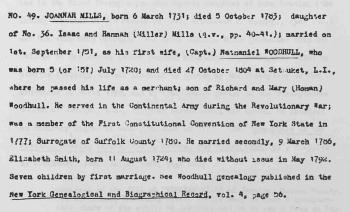
NO. 49. JOANNAH MILLS, born 6 March 1731; died 5 October 1783; daughter of No. 36. Isaac and Hannah (Miller) Mills (q.v., pp. 40-41.); married on 1st. September 1751, as his first wife, (Capt.) Nathaniel WOODHULL, who was born 5 (or 15t) July 1720; and died 27 October 1804 at Setauket, L. I. , where he passed his life as a merchant; son of Richard and Mary (Homan) Woodhull. He served in the Continental Army during the Revolutionary War; was a member of the First Constitutional Convention of New York State in 1777; Surrogate of Suffolk County 1780. He married secondly, 9 March 1786, Elizabeth Smith, born 11 August 1724; who died without issue in May 1792. Seven children by first marriage. See Woodhull genealogy published in the New York Genealogical and Biographical Record, vol. 4, page 56.
— 01 May 1939, A Documentary history of the family of Mills : descended from George Mills of Hempstead and Jamaica by Lewis D. Cook, p46, familysearch.org. View largest available size.

- Joanna5 b. March 6, 1731, md. Capt. Nathan Woodhull in 1750 and died Oct. 5, 1783 aged 51, leaving Nathan,6* Nathaniel,6 David,6 Sarah,6 Phebe6, Joanna6 and Benjamin6. Capt. Woodhull and family lived at Setauket where his children were born.
— 1919, Genealogies of Long Island families : a collection of genealogies relating to the following Long Island families: Dickerson, Mitchill, Wickham, Carman, Raynor, Rushmore, Satterly, Hawkins, Arthur Smith, Mills, Howard, Lush, Greene, Compiled by Charles J. Werner, Mainly From Records Left By Benjamin F. Thompson, Historian of Long Island, p106, Logan Utah FamilySearch Library, familysearch.org. View largest available size.
This Nathan is not to be confused with either Captain Nathaniel Woodhull (28 Jul 1769 to 18 Jan 1802) or that Captain Nathaniel Woodhull’s uncle, Revolutionary War hero General Nathaniel Woodhull (30 Dec 1722, Mastic, Long Island to 20 Sep 1776) who was captured and eventually killed by the British in Jamaica Queens NY during the Battle of Long Island.
General Nathaniel Woodhull (December 30, 1722 – September 20, 1776) was a leader of the New York Provincial Congress and a brigadier general of the New York Militia during the American Revolution.
Woodhull was born on December 30, 1722, in Mastic, Long Island, Province of New York, to Nathaniel Woodhull and Sarah Smith Woodhull. His family had been prominent in New York affairs since the mid seventeenth century.
In 1758 the thirty-six year old Woodhull joined the New York provincial forces, where he held the rank of major. He fought in numerous battles during the French and Indian War. He was at the Battle of Carillon under General Abercromby, and at the Battle of Fort Frontenac under General Bradstreet. In 1760, as colonel of the 3rd Regiment of New York Provincials took part in the invasion of Canada under General Amherst. After the end of hostilities, he returned to farming and community affairs.
In 1761 he married Ruth Floyd, the sister of William Floyd a signer of the Declaration of Independence. Sentiment against England's taxation of the colonies led to Suffolk County electing Woodhull to Province of New York assembly. From 1769 to 1775 he served as a member of the Province of New York assembly for Suffolk County. As such, he spoke against the Crown's colonial policies. He represented Suffolk also in the convention which chose delegates to the First Continental Congress, and in the New York Provincial Congress. In May 1775, the Provincial Congress assumed control of the colony and reorganized the militia. In August, 1775, Woodhull was elected president of the New York Provincial Congress.In October 1775 he was made brigadier general of the Suffolk and Queen's County militia. In August 1776, on the eve of the Battle of Long Island, Woodhull's militia was detailed to drive livestock east to prevent its falling into British hands. Woodhull's troops had driven 1,400 cattle out onto the Hempstead Plains and with 300 more ready to go. A severe thunderstorm drove the general to take refuge in a tavern run by Increase Carpenter, about two miles east of Jamaica in what is now Hollis. Relief was not forthcoming, and his situation deteriorated.Woodhull was captured near Jamaica by a detachment of Fraser's Highlanders led by captain Sir James Baird. He was struck with a sword multiple times, injuring his arm and head by a British officer purportedly for not saying, "God save the King", as ordered, saying instead "God save us all". He was taken to a cattle transport, serving as a prison ship in Gravesend Bay. A sympathetic British officer had him transferred to the century-old house built by Nicasius di Sille in the Dutch village of New Utrecht which is now a part of Brooklyn. The house was demolished in 1850 by the owner Baret Wyckoff. It was located in the current vicinity of 84th St. and New Utrecht Ave. His arm was amputated in an effort to save his life, he managed to call for his wife who was at his side when he died on September 20, 1776. He was buried at his family home.
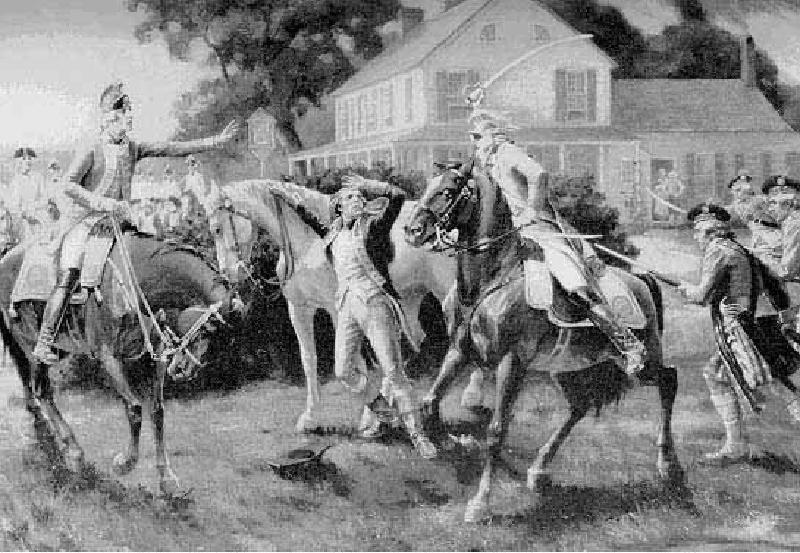
— The Capture of Nathaniel Woodhull, public domain image uploaded by anonymous member, wikipedia.org. View largest available size.
The killing of General Woodhull was yet another act of British cruelty that further galvanized the Patriots in the cause of independence.
The Woodhull name was widespread on Long Island and can be found in a number of other family genealogies, including the descendants of Timothy Mills. General Nathaniel Woodhull’s name has since been adopted by a number of schools, as well as Adam Smith’s hometown:
Official formation of Woodhull, named after General Nathanial Woodhull was done by an act of Legislature on February 18, 1828. Formerly part of Middletown it took lands from Rathbone, Troupsburge and Addison. Woodhull now includes the hamlets of Hedgesville and Borden.
— Leslie Smith, Woodhull – A Brief History, p1.